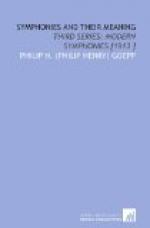[Music: (Muted strings) (Horns and bassoons)]
A melody in the minor plays first in a choir of horns and bassoons, later in united strings, accompanied by soft rolls of drums and a touch of the lowest brass. Harp and higher woodwind are added, but the volume is never transcendent save in a single burst when it is quickly hushed to the first ominous whisper. Out of this sombre song flows a romance of tender sentiment, tranquillo in strings, followed by the wood. The crossing threads of expressive melody
[Music: Tranquillo (Strings) (In the midst enters a strain of solo horn)]
rise in instant renewal of stress and agitation. The joy of battle has returned, but it seems that the passion of love burns in midst of the glow of battle, each in its separate struggle, and both together in one fatal strife. The sombre melody returns in full career, dying down to a pause.[A]
[Footnote A: In a somewhat literal commentary attributed to Dr. Richard Batka, the Amazons here, “having reached their destination, go into night-encampment—as represented by the subdued roll of the kettle-drums, with which the movement concludes.”]
Molto sostenuto, in changed rhythm of three slow beats, comes “Penthesilea’s Dream of the Feast of Roses.” Over a thick cluster of harmonies in harp and strings the higher wood sing a new song in long drawn lyric notes with ravishing turns of tonal color,—a
[Music: Molto sostenuto (Flutes, oboes and clarinets) (Rapid arpeggic figures of harps and muted strings)]
dual song and in many groups of two. The tranquil current of the dream is gradually disturbed; the main burden is dimmed in hue and in mood. Faster, more fitful is the flow of melody, with hostile intruding motive below; it dashes at last into the tragic phase—Combats; Passions; Madness; Destruction—in very rapid tempo of 2/2 rhythm.
In broad, masterful pace, big contrary figures sweep up and down, cadencing in almost joyous chant, gliding, indeed, into a pure hymn, as of triumph (that harks back to the chorussing song in the beginning).
Throughout the poem the musical symbols as well as the motives of passion are closely intertwined. Thus the identity of the impetuous phrase of the very beginning is clear with the blissful theme of the Dream of the Feast of Roses. Here, at the end of the chorussing verse is a play or a strife of phrases where we cannot escape a symbolic intent. To tremolo of violas the cellos hold a tenor of descending melody over a rude rumbling phrase of the basses of wood and strings, while the oboe sings in the treble an expressive answer of ascending notes. A conflict is
[Music: (Molto vivace)
(cello molto espressivo)
(Violas)
(Basses and bassoons with upper 8ve.)
(Oboe) espressivo]
evident, of love and ambition, of savage and of gentle passion, of chaos and of beauty. At the height, the lowest brass intrude a brutal note of triumph of the descending theme. To the victory of Pride succeeds a crisis of passionate yearning. But at the very height is a plunge into the fit of madness, the fatal descending phrase (in trombones) is ever followed by furious pelting spurts in the distorted main theme.




